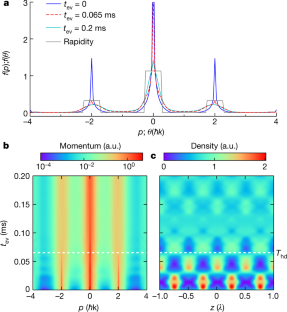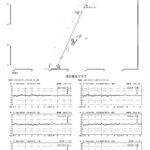超低温原子ガスを用いた新しい実験により、すべての相互作用する量子系が急激なエネルギー流入の後にどのように進化するかに光が当たる New experiments with ultra-cold atomic gases shed light on how all interacting quantum systems evolve after a sudden energy influx
2023-05-17 ペンシルベニア州立大学(PennState)
◆研究チームは、これらのガスが共通の特徴を持つように「進化」することを示しました。具体的には、エネルギーの大きな流入によって系が非平衡状態になった後、1次元運動量分布の時間的な変化を観測しました。
◆この研究は、量子多体系の非平衡状態の振る舞いに関する理解を深め、エネルギーを大量に加える場合の多数の量子系に応用できる理論を提供しています。
<関連情報>
- https://www.psu.edu/news/eberly-college-science/story/uncovering-universal-physics-dynamics-quantum-system/
- https://www.nature.com/articles/s41586-023-05979-9
1次元ボーズ気体における流体力学化と局所的なプレサーマライゼーションの観測に成功 Observation of hydrodynamization and local prethermalization in 1D Bose gases
Yuan Le,Yicheng Zhang,Sarang Gopalakrishnan,Marcos Rigol & David S. Weiss
Nature Published:17 May 2023
DOI:https://doi.org/10.1038/s41586-023-05979-9

Abstract
Hydrodynamics accurately describe relativistic heavy-ion collision experiments well before local thermal equilibrium is established1. This unexpectedly rapid onset of hydrodynamics—which takes place on the fastest available timescale—is called hydrodynamization2,3,4. It occurs when an interacting quantum system is quenched with an energy density that is much greater than its ground-state energy density5,6. During hydrodynamization, energy gets redistributed across very different energy scales. Hydrodynamization precedes local equilibration among momentum modes5, which is local prethermalization to a generalized Gibbs ensemble7,8 in nearly integrable systems or local thermalization in non-integrable systems9. Although many theories of quantum dynamics postulate local prethermalization10,11, the associated timescale has not been studied experimentally. Here we use an array of one-dimensional Bose gases to directly observe both hydrodynamization and local prethermalization. After we apply a Bragg scattering pulse, hydrodynamization is evident in the fast redistribution of energy among distant momentum modes, which occurs on timescales associated with the Bragg peak energies. Local prethermalization can be seen in the slower redistribution of occupation among nearby momentum modes. We find that the timescale for local prethermalization in our system is inversely proportional to the momenta involved. During hydrodynamization and local prethermalization, existing theories cannot quantitatively model our experiment. Exact theoretical calculations in the Tonks–Girardeau limit12 show qualitatively similar features.



